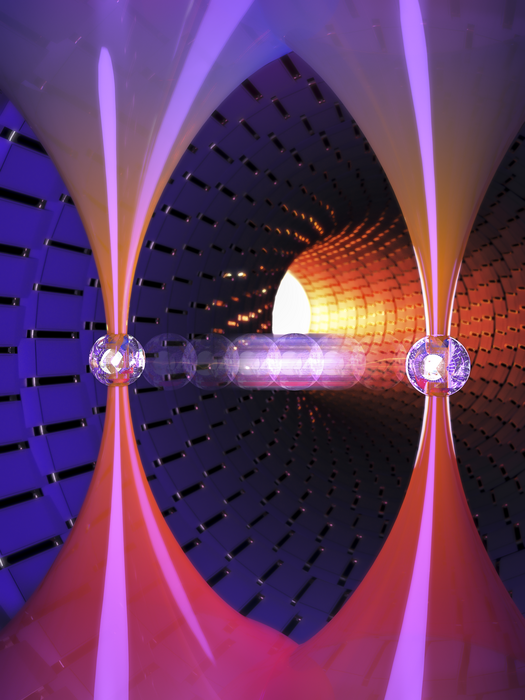WASHINGTON —In many baseball-obsessed countries like Korea, Japan and the United States, with spring months comes the start of the season and quite a few balls flying through the air. But it’s not just balls that can be thrown. On the tiniest field imaginable, scientists have now shown they can also throw and catch individual atoms using light.

Credit: Jaewook Ahn, Korea Advanced Institute of Science and Technology
WASHINGTON —In many baseball-obsessed countries like Korea, Japan and the United States, with spring months comes the start of the season and quite a few balls flying through the air. But it’s not just balls that can be thrown. On the tiniest field imaginable, scientists have now shown they can also throw and catch individual atoms using light.
This amazing feat was achieved with optical traps, which use a highly focused laser beam to hold and move tiny objects. Although optical traps have been used to move individual atoms before, this is the first time an atom has been released from a trap — or thrown — and then caught by another trap.
“The freely flying atoms move from one place to the other without being held by or interacting with the optical trap,” said research team member Jaewook Ahn from the Korea Advanced Institute of Science and Technology. “In other words, the atom is thrown and caught between the two optical traps much like the ball travels between the pitcher and a catcher in a baseball game.”
In Optica, Optica Publishing Group’s journal for high-impact research, the researchers report successfully throwing chilled rubidium atoms over a distance of 4.2 micrometers at a speed up to 65 centimeters per second. The technology could be used to make quantum computers, which use quantum physics to solve problems too complex for classical computers.
“These types of flying atoms could enable a new type of dynamic quantum computing by allowing the relative locations of qubits — the quantum equivalent to binary bits — to be more freely changed,” said Ahn. “It could also be used to create collisions between individual atoms, opening a new field of atom-by-atom chemistry.”
How do you catch a flying atom?
The new research is a part of ongoing quantum computing project that involves using optical traps to arrange atoms into a particular array. “We often encountered arrangement errors that rendered an array defective,” said Ahn. “We wanted to find an efficient way to fix a defective array without having to move a large number of atoms, because that could result in even more defects.”
To create free-flying atoms, the researchers chilled rubidium atoms to close to 0 K (near absolute zero of temperature) and formed optical traps with an 800 nm laser. To throw an atom, they accelerate the optical trap holding it and then turn the trap off. This causes the atom to launch out of the trap. Another trap is then turned on to capture the incoming atom and decelerated until the atom stops completely.
To test their method, the researchers performed a set of proof-of-principle demonstrations. In addition to throwing and catching atoms, they showed that the atoms could be thrown through another stationary optical trap and weren’t affected by other atoms encountered along the way. They also used their method to create arrays of atoms.
In the experiments, the researchers successfully created free-flying atoms about 94 percent of the time. They are now working to fine tune the technique to get closer to 100 percent success.
Paper: H. Hwang, A. Byun, J. Park, S. de L´es´eleuc, J. Ahn, “Optical tweezers throw and catch single atoms,”10, 3. DOI: doi.org/10.1364/OPTICA.480535.
About Optica
Optica is an open-access journal dedicated to the rapid dissemination of high-impact peer-reviewed research across the entire spectrum of optics and photonics. Published monthly by Optica Publishing Group, the Journal provides a forum for pioneering research to be swiftly accessed by the international community, whether that research is theoretical or experimental, fundamental or applied. Optica maintains a distinguished editorial board of more than 60 associate editors from around the world and is overseen by Editor-in-Chief Prem Kumar, Northwestern University, USA. For more information, visit Optica.
About Optica Publishing Group (formerly OSA)
Optica Publishing Group is a division of Optica (formerly OSA, Advancing Optics and Photonics Worldwide. It publishes the largest collection of peer-reviewed content in optics and photonics, including 18 prestigious journals, the society’s flagship member magazine, and papers from more than 835 conferences, including 6,500+ associated videos. With over 400,000 journal articles, conference papers and videos to search, discover and access, Optica Publishing Group represents the full range of research in the field from around the globe.
Journal
Optica
DOI
10.1364/OPTICA.480535
Article Title
Optical tweezers throw and catch single atoms
Article Publication Date
9-Mar-2023




